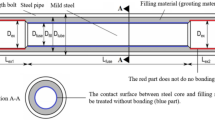Abstract
Based on Wiener process model, a new approach for reliability evaluation of cross-linked polyethylene (XLPE) is proposed to improve the lifetime evaluation reliability of XLPE under multi-stressing conditions and study the failure probability distribution. In this paper, two accelerated aging tests are carried out under combined thermal and vibration conditions. The volume resistance degradation data of XLPE samples are tested with a 24 h interval under the accelerated stressing conditions at (130 °C, 12 m/s2) and (150 °C, 8.5m/s2), respectively. Nonlinear degradation data obtained from the experiment are transformed to linear intermediate-variable values using time scaling function, and then linearized degradation data are calculated and evaluated on the basis of linear Wiener process model. Considering traditional Arrhenius equation and inverse power criterion, parameters of the linear Wiener model are estimated according to the maximum likelihood function. The relationship curves on probability density and reliability are given, and the lifetime distribution of XLPE under different stressing conditions is also obtained for evaluating the reliability of XLPE insulation. Finally, the life expectancy of XLPE is 17.9 a under an allowance temperature of 90 °C and an actual vibration acceleration of 0.5m/s2. The approach and results in this paper may be used for reliability assessment of high-voltage multiple samples or apparatuses.
Similar content being viewed by others
References
LEGUENZA E L, ROBERT R, MOURA W A, et al. Dielectric behavior of XLPE aged under multistressing conditions [C]//12th International Symposium on Electrets. [s.l.]: ISE, 2005: 254–257.
ARAS F, ALEKPEROV V, CAN N, et al. Aging of 154 kV underground power cable insulation under combined thermal and electrical stresses [J]. IEEE Electrical Insulation Magazine, 2007, 23(5): 25–33.
MAZZANTI G. The combination of electro-thermal stress, load cycling and thermal transients and its effects on the life of high voltage ac cables [J]. IEEE Transactions on Dielectrics and Electrical Insulation, 2009, 16(4): 1168–1179.
DANG C, PARPAL J L, CRINE J P. Electrical aging of extruded dielectric cables review of existing theories and data [J]. IEEE Transactions on Dielectrics and Electrical Insulation, 1996, 3(2): 237–247.
LUO P, XU Y, GU X, et al. Thermal and mechanical properties analysis for EHV XLPE cables with different operating years [C]//Annual Report Conference on Electrical Insulation and Dielectrics Phenomena. [s.l.]: IEEE, 2013: 47–51.
MAZZANTI G. Analysis of the combined effects of load cycling, thermal transients, and electrothermal stress on life expectancy of high-voltage AC cables [J]. IEEE Transaction on Power Delivery, 2007, 22(4): 2000–2009.
FOTHERGILL J C, DODD S J, DISSADO L A, et al. The measurement of very low conductivity and dielectric loss in XLPE cables: A possible method to detect degradation due to thermal aging [J]. IEEE Transactions on Dielectrics and Electrical Insulation, 2011, 18(5): 1544–1553.
LALL P, LOWE R, GOEBEL K. Prognostication of accrued damage in board assemblies under thermal and mechanical stresses [C]//IEEE 62nd Electronic Components and Technology Conference. [s.l.]: IEEE, 2012: 1475–1487.
AL-ARAINY A, MALIK N H, QURESHI M I, et al. The performance of strippable and bonded screened medium-voltage XLPE-insulation cables under longterm accelerated aging [J]. IEEE Transactions on Power Delivery, 2007, 22(2): 744–751.
TZIMAS A, ROWLAND S, DISSADO L A, et al. Effect of long-time electrical and thermal stresses upon the endurance capability of cable insulation material. [J]. IEEE Transactions on Dielectrics and Electrical Insulation, 2009, 16(5): 1436–1443.
FABIANI D, SIMONI L. Discussion on application of the Weibull distribution to electrical breakdown of insulating materials [J]. IEEE Transactions on Dielectrics and Electrical Insulation, 2005, 12(1): 11–16.
KORZHOVA M E, KORZHOV A V. Weibull distribution parameters in electrical insulation reliability assessment [C]//2nd International Ural Conference on Measurement. [s.l.]: IEEE, 2017: 409–414.
GEBRAEEL N Z, LAWLEY M A, LI R, et al. Residual-life distributions from component degradation signals: A Bayesian approach [J]. IIE Transactions, 2007, 37(6): 543–557.
MAZZANTI G. The combination of electro-thermal stress, load cycling and thermal transient and its effects on the life of high voltage AC cables [J]. IEEE Transactions on Dielectrics and Electrical Insulation, 2009, 16(4): 1168–1179.
MUSALLAM M, JOHNSON C M. Monitoring through-life thermal path degradation using real time thermal models [C]//IEEE Power Electronics Specialists Conference. [s.l.]: IEEE, 2008: 738–743.
SU C, JIANG Y H. Forecasting model for degradation path and parameter estimation based on neural network [C]//2009 16th International Conference on Industrial Engineering and Engineering Management. 2009: 1735–1738.
ZUO M J, JIANG R Y, YAM R C M. Approaches for reliability modeling of continuous-state devices [J]. IEEE Transactions on Reliability, 1999, 48(1): 9–18.
HUANG W, DIETRICH D L. An alternative degradation reliability modeling approach using maximum likelihood estimation [J]. IEEE Transactions on Reliability, 2005, 54(2): 310–317.
PENG C Y, TSENG S T. Statistical lifetime inference with skew-Wiener linear degradation models [J]. IEEE Transactions on Reliability, 2013, 62(2): 338–350.
LING M H, BALAKRISHMAN N. Model misspecification analyses of Weibull and Gamma models based on one-shot device test data [J]. IEEE Transactions on Reliability, 2017, 66(3): 641–650.
TSAI C C, TSENG S T, BALAKRISHNAN N. Optimal design for degradation tests based on Gamma processes with random effects [J]. IEEE Transactions on Reliability, 2012, 61(2): 604–613.
JIN G, MATTHEWS D. Reliability demonstration for long-life products based on degradation testing and a Wiener process model [J]. IEEE Transactions on Reliability, 2014, 63(3): 781–797.
SI X S, WANG W B, HU C H, et al. Remaining useful life estimation based on a nonlinear diffusion degradation process [J]. IEEE Transactions on Reliability, 2012, 61(1): 50–56.
Author information
Authors and Affiliations
Corresponding author
Additional information
Foundation item: the National Key R&D Program of China (No. 2017YFB0902705)
Rights and permissions
About this article
Cite this article
Liu, J., Zhang, M., Chen, X. et al. Approach for Reliability Evaluation of Cross-Linked Polyethylene Under Combined Thermal and Vibration Stresses. J. Shanghai Jiaotong Univ. (Sci.) 23, 758–763 (2018). https://doi.org/10.1007/s12204-018-1980-3
Received:
Published:
Issue Date:
DOI: https://doi.org/10.1007/s12204-018-1980-3
Key words
- accelerated multifactor aging
- lifetime evaluation
- reliability distribution
- degradation test
- crosslinked polyethylene (XLPE)




